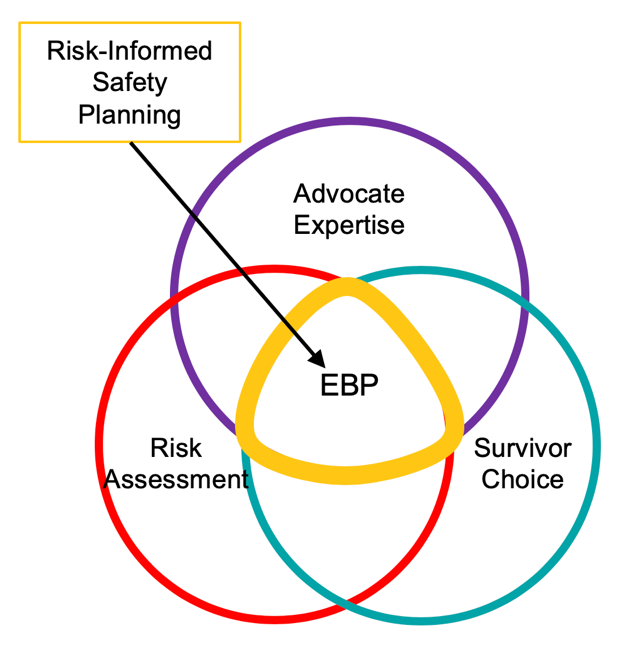On a global scale, the highest homicide risk for women is murder by an intimate partner; a conservative estimate puts the worldwide estimate for the percent of women killed by an intimate partner at 38.6%.
Risk Assessment
Risk assessments provide information about the likelihood that a victim of domestic violence will be re-assaulted, severely re-assaulted, or killed by their intimate partner. It is important that practitioners use risk assessment within an evidence-based practice approach. Evidence-based practice is at the intersection of advocate expertise, risk assessment, and survivor choice. Risk-informed safety planning uses an assessment of a perpetrator’s risk, advocate expertise, and survivor choice to inform safety planning with survivors of intimate partner violence.

Messing, J.T. (2019). Risk-Informed intervention: Using intimate partner violence risk assessment within an evidence-based practice framework. Social Work, 64(2), 103-112.
The Danger Assessment
The Danger Assessment (DA) is the only risk assessment intended to predict homicide. Dr. Jacquelyn Campbell developed the Danger Assessment by comparing the risk factors present in cases of intimate partner homicide with the risk factors present in cases of intimate partner violence (https://www.dangerassessment.org/). The Danger Assessment has been validated across multiple studies. The Danger Assessment Technical Assistance Center has a mission to translate research findings into evidence-based practices to support victim-survivor decisions and prevent intimate partner homicide.
Versions of the Danger Assessment have been adapted for use in risk-informed collaborative interventions. In the majority of these interventions, risk assessments are used at the scene of police-involved domestic violence incidents to place survivors in contact with domestic violence victim advocates.
For information about the PAIRS study, please reach out to our team.
 dow_presentation_10_25_21_final.pdf
dow_presentation_10_25_21_final.pdf
Messing, J.T.,Campbell, J.C., & Snider, C. (2017). Validation and adaptation of the Danger Assessment-5 (DA-5): A brief intimate partner violence risk assessment. Journal of Advanced Nursing, 73, 3220-3230.
Messing, J.T. & Campbell, J.C. (2016). Informing collaborative interventions: Intimate partner violence risk assessment for front line police officers. Policing: A Journal of Policy & Practice, 10(4), 328-340
Messing, J.T., Campbell, J., Webster, D.W., Brown, S., Patchell, B., & Wilson, J.S. (2015). The Oklahoma Lethality Assessment Study: A quasi-experimental evaluation of the Lethality Assessment Program. Social Service Review, 89(3), 499-530.
Arizona intimate Partner Risk Assessment Instrument System (APRAIS)
The APRAIS is an example of a risk-informed collaborative intervention that is used across Arizona. The APRAIS tool predicts near lethal violence and is used at the scene of domestic violence incidents to place survivors in contact with domestic violence advocates. The AZ Supreme Court recently ruled that a risk assessment and intervention developed and tested by Dr. Messing is recommended for use at the scene of domestic violence incidents throughout Arizona.
To see a copy of the APRAIS assessment click here.
Dr. Messing is currently evaluating the APRAIS through a grant from the Office of Violence Against Women.

